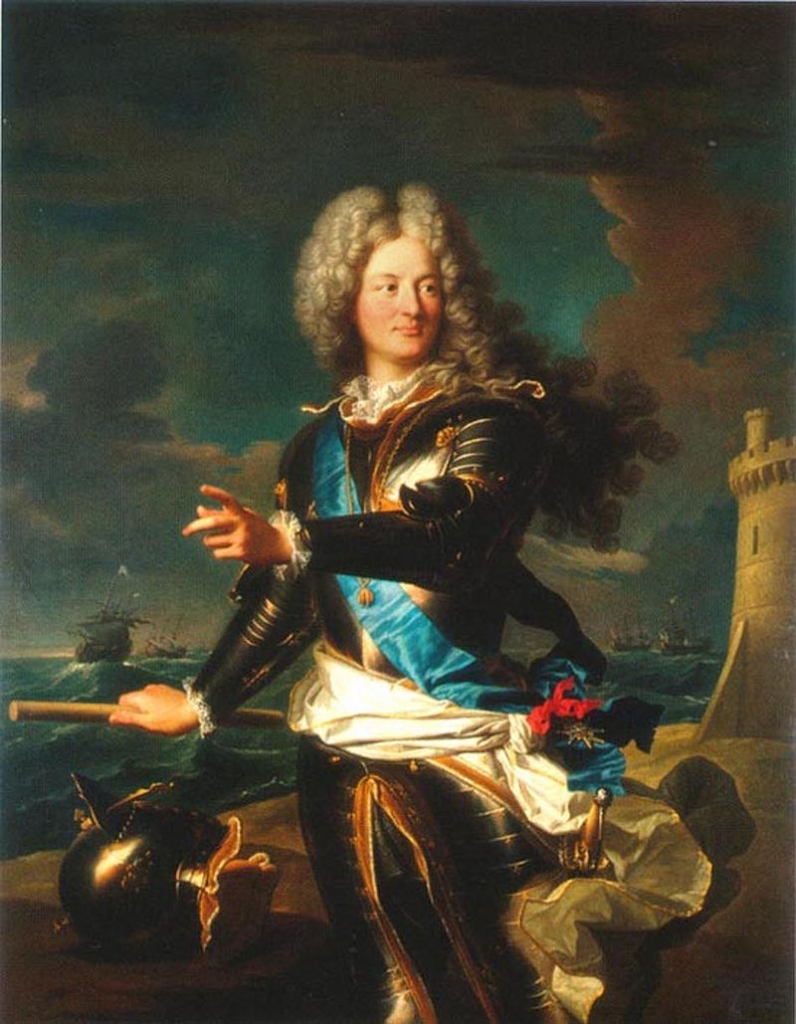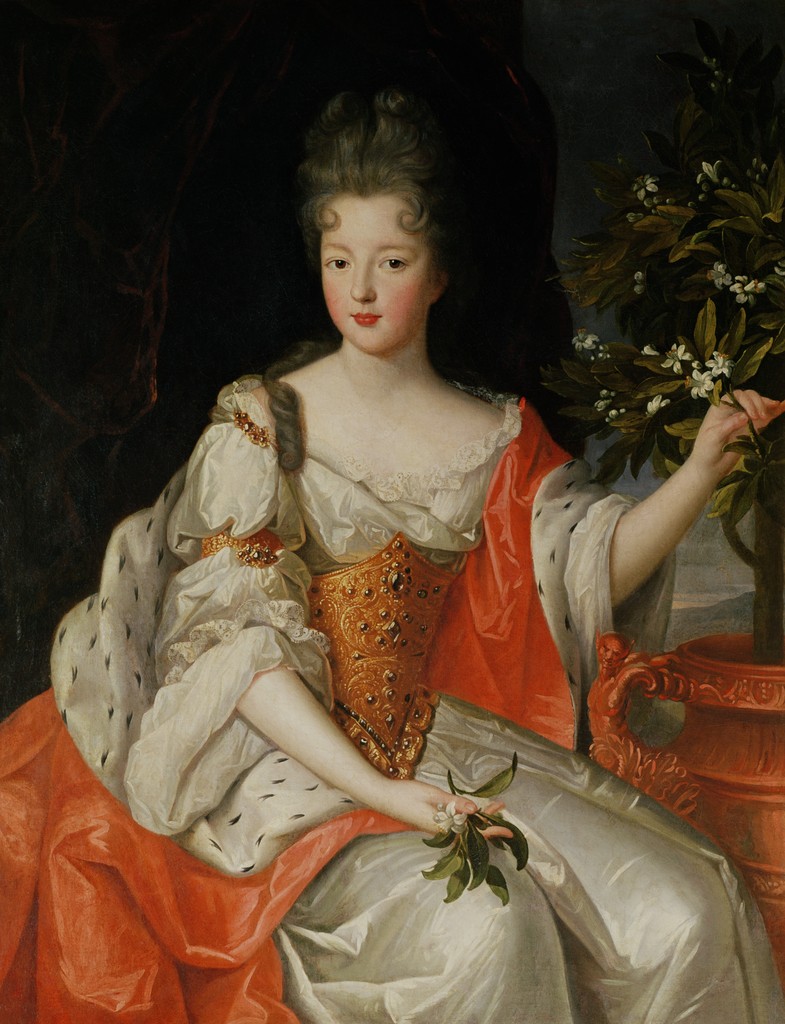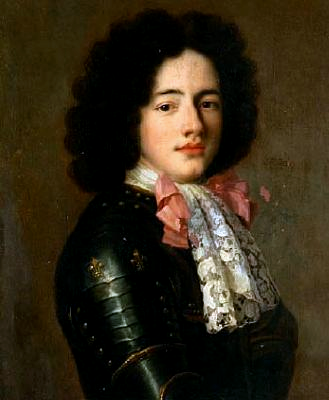Louis-Alexandre de Bourbon, Comte de Toulouse
Born on 6 June in 1678, Louis-Alexandre was the youngest of Louis XIV and Madame de Montespan, and named after his papa and Alexander the Great.

At the time of this last pregnancy, Madame de Montespan was already declining in favour, while her former friend the widow Scarron, who in the meanwhile entered the ranks of nobility as Marquise de Maintenon, rose in favour. Madame de Maintenon had gained the King’s trust and ear and she became a pleasant distraction from Madame de Montespan for him. The latter had become a little too demanding, too exhausting, too irritating at times for Louis XIV. He began to question his choices, under influence of the pious Madame de Maintenon… which in turn made him ogle other ladies. Madame de Maintenon did not like that one bit, of course. She wished Louis would simply be happy with what he had, not Montespan, but with his wife. After all, he was married and committing adultery.
Thus it is not surprising that Madame de Maintenon was not happy as she heard of Madame de Montespan being pregnant once more. She was the doting governess, and second mother, to five children the King had with Madame de Montespan already… and loved some of them as if they were her own… but adultery remains a sin, no matter if the product of it is an adorable little creature that takes the hearts of everyone by storm. It was not the first time Madame de Maintenon had opted her protest in matters of royal-groin-to-mistress contact. She had already done so during la Montespan’s previous pregnancy with Françoise-Marie… and that had been not even a year ago. So, Louis XIV decided to have his new offspring placed into different hands, he had done it with Françoise-Marie too, and Madame de Maintenon might have also managed to talk him into ceasing the royal-groin-to-mistress contact… at least, his dear Athénaïs was not blessed with another pregnancy afterwards…
Little Louis-Alexandre, being born at his mother’s Château de Clagny northeast of the Château de Versailles, was trusted into the care of Madame Colbert, and a Madame de Jussac, and so never enjoyed the spoiling of Madame de Maintenon. Which was not a bad thing, then compared to those of his sibling who had enjoyed the spoiling, Louis-Alexandre turned out to be among those more decent of character.
While Louis might have decided not to visit the bed of Madame de Montespan anymore, he still showered her with signs of affection and expensive gifts, doing the same with his children by her. Like his older siblings before, Louis-Alexandre was legitimised in 1681 and with that received the right to call himself de Bourbon as well as Légitimé de France. He missed out a little in matters of titles, receiving that of Comte de Toulouse while his older brother was made a Duc after his legitimisation 1673.

In 1683, Louis-Alexandre’s disgraced half-brother Louis, Comte de Vermandois, died at the age of sixteen far away from home during a military campaign. Vermandois had been made Amiral de France when he was only two years old and Louis XIV decided to grant said office to Louis-Alexandre, then five years old, after the death of Vermandois. It proved to be a good decision.
The following year, 1684, the Comte de Toulouse became colonel of an infantry regiment named after him. Quite a lot of responsibility for a boy that young… but Louis-Alexandre did not have to take care of it himself. His papa dealt with the maritime affairs for him, the very reason the position was granted in the first place, so that Louis XIV could be in full control of it until Toulouse came of age.
Madame de Montespan’s rumoured involvement in the affaire des poisons ended her days as love-interest of Louis XIV. The King insisted to act as if nothing had happened in public, but in private it was an entirely different matter. He did not trust her any longer and did not visit her apartment alone anymore. La Montespan still acted the glorious mistress for the court, but those days were over. With more free times at her hands, she was resolved to invest herself more in the upbringing and education of her youngest children. Thus Louis-Alexandre had the chance to experience something his older siblings did not so much, namely to have a proper mother that taught him lasting lessons in values and beliefs.
As the Comte de Toulouse was fourteen years old, in 1692, he accompanied his father and the court to the Siege of Namur, major military engagement of the Nine Years’ War. It ended in a victory for France and apparently an injury for Louis-Alexandre. The next year, Louis-Alexandre was promoted again, this time to mestre de camp of a regiment of cavalry, and welcomed into the ranks of the ordre du Saint-Esprit… not the last promotion, for in 1696 he was made maréchal de camp and the next year lieutenant général des armées du Roi. By then the Comte de Toulouse was already governor of a province. He was given government of Guyenne in January 1689, but exchanged Guyenne for Bretagne in 1695. And Louis-Alexandre also became a Duc, later than his brother, but better later than never. He was made Duc de Penthièvre in 1697 and in 1711 Duc de Rambouillet, but stuck with Comte de Toulouse.
The Sun King loved to promote his sons into important military positions. He had done so with the Duc du Maine already, but while Maine was not really made for war and his efforts not that successful, Toulouse made a better figure… much to the annoyance of Madame de Maintenon, Maine was her favourite and she never really wanted to have much to do with Toulouse, but Toulouse was better at winning glory for his papa and on top of it, the court liked Toulouse more since he had a less irritating character and good heart.
The Battle of Málaga in 1704, largest naval battle in the War of the Spanish Succession, did not go too well for Toulouse, but his nephew, Philip V of Spain, made him a Knight of the Golden Fleece anyway. Louis-Alexandre was twenty-six years old then.

The biggest promotion for Louis-Alexandre came in 1714, one year before his father died. He and the Duc du Maine were made Princes du Sang by their father and given the right to succeed to the throne. A real big scandal. Many of the ‘real’ Princes du Sang protested and were successful with it in the end, for the whole thing was revoked in 1717. While Maine, disliked for his arrogance and jealousy, lost all of his political power, Toulouse did however not. The protesting Ducs and Peers held him in higher esteem due to his more pleasant character. Thus Louis-Alexandre was made Minister of the Navy shortly after.
Louis-Alexandre was still a bachelor at that point, but already a father. He had two out-of-wedlock children with Madeleine Aumont: Louis-Alexandre de Sainte-Foy, born in 1720, died in infancy. Philippe-Auguste de Sainte-Foy, called Chevalier d’Arq, was born in 1721 and died in 1795.
The Comte de Toulouse did not marry until 1723… and then in secret. Louis-Alexandre had in mind to marry Mademoiselle d’Armagnac, a daughter of Louis de Lorraine, but the marriage plan was opposed by the young Louis XV. Mademoiselle d’Armagnac never married. The Comte de Toulouse did. He fell in love with Marie-Victoire-Sophie de Noailles, widow of the Marquis de Gondrin, and married her in a secret ceremony. Said marriage was not announced at once, because there was a bit of a problem with it….
Marie-Victoire’s first husband was the grandson of Madame and Monsieur de Montespan, thus Toulouse was the ten-year younger uncle of Marie-Victoire’s first husband. A bit strange. The couple moved into the apartment previously occupied by Madame de Montespan at Versailles and had one son: Louis Jean Marie de Bourbon, born on 16 November in 1725. This Louis Jean, being himself a grandson of Madame de Montespan, married a great-granddaughter of Madame de Montespan.
Louis XV was quite fond of Toulouse and often went hunting with him. Louis-Alexandre was smart enough to stay away from the intrigues of the court, thus remained in the good graces of nearly everyone. He retired to his chateau at Rambouillet and died there on 1 December in 1737 after following an operation.



